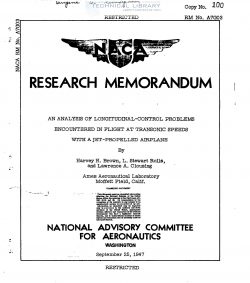naca-rm-a7g03
- Version
- 98 Downloads
- 1.46 MB File Size
- 1 File Count
- April 20, 2017 Create Date
- April 20, 2017 Last Updated
National Advisory Committee for Aeronautics, Research Memorandum - An Analysis of Longitudinal-Control Problems Encountered in Flight at Transonic Speeds with a Jet Propelled Airplane

During flight tests of a set-propelled airplane, a sudden
pitch—up motion of the airplane occurred. in a recovery from a high-
speed dive, although the pilot had not moved the controls so as to
produce this motion. The pitch—up occurred at a Mach number of 0.85
as the Mach nmber was being decreased from 0.866 and resulted in a
change of lift coefficient from 0.19 to 0.89 in about 1 second.
Measurements of the stability and control characteristics of
the airplane and of the wing pressure distribution during the dive
and recovery are presented.
An analysis based on flight and wind—hmnel data indicated the
probable causes of the abrupt pi toh-up were an abrupt restoration
of elevator effectiveness and a nose—up change in balance caused by
a shift in the angle of attack for zero lift both due to the
decreasing Mach number.
During flight tests of a Jet—propelled airplane conducted for
the purpose of obtaining high—speed aerodynamic characteristics,
several problems of high—speed flight were encountered. Some of the
data obtained and a discussion of the problems encountered were
presented in reference 1 which dealt with wing-pressure measurements.
On one of the flights the'airplane‘ abruptly pitched up to the
stall in about 1 second during a dive recovery. This abrupt
pitching—up motion was experienced at a Mach number of 0.85 as the
Mach number of flight was being decreased from a value of 0.866,
although the.pilot had not moved the controls significantly. The
airplane had not exhibited this trait in pull—outs up to the stall
at lover Mach numbers.
Because preliminary analysis indicated that the action of the
horizontal tail was responsible for the abrupt pitch—up, tests were
made of a l/3—scale model of the horizontal tail in the Ames 16—foot
high~speed wind tunnel up to the Mach numbers attained in flight.
Because it appeared that a swept tail would alleviate or eliminate
the pitchingqmoment effects, wind—tunnel tests were also made of
the tail with the quarter—chord line swept back 56.50.
This report presents an analysis based on flight and windptunnel
test data directed toward the determination of the probable cause of
the abrupt pitch—up. Wing pressure distributions and stability and
control characteristics in the dive are also included.
| File | Action |
|---|---|
| naca-rm-a7g03 An Analysis of Longitudinal-Control Problems Encountered in Flight at Transonic Speeds with a Jet Propelled Airplane.pdf | Download |

Comment On This Post